1998 HONDA ODYSSEY weight
[x] Cancel search: weightPage 8 of 272
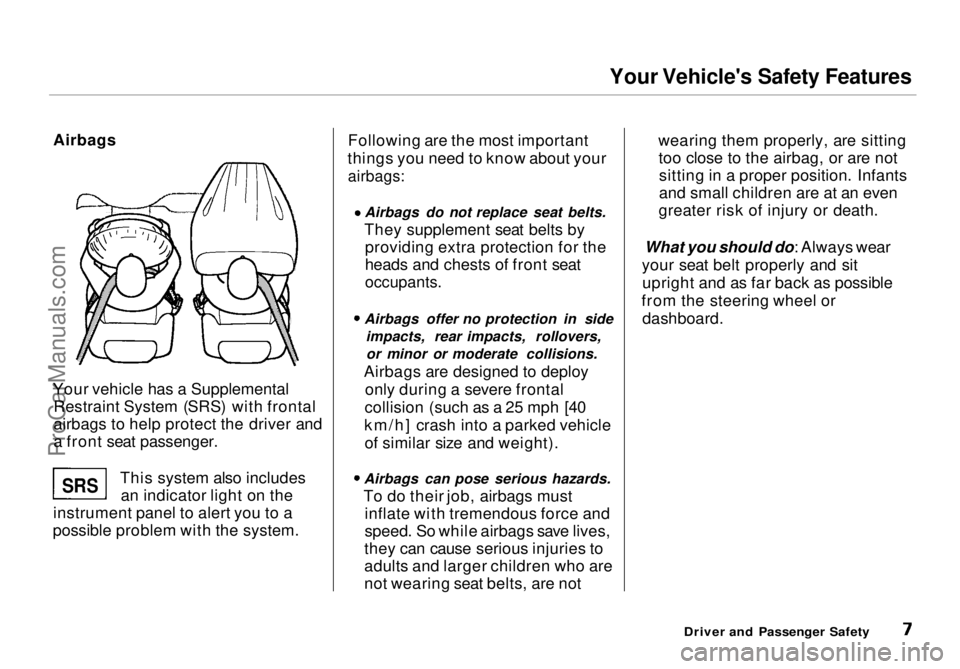
Your Vehicle's Safety Features
Airbags
Your vehicle has a Supplemental Restraint System (SRS) with frontal
airbags to help protect the driver and
a front seat passenger.
This system also includesan indicator light on the
instrument panel to alert you to a
possible problem with the system. Following are the most important
things you need to know about your
airbags:
Airbags do not replace seat belts.
They supplement seat belts by providing extra protection for the
heads and chests of front seat
occupants.
Airbags offer no protection in side impacts, rear impacts, rollovers,or minor or moderate collisions.
Airbags are designed to deploy only during a severe frontal
collision (such as a 25 mph [40
km/h] crash into a parked vehicle of similar size and weight). Airbags can pose serious hazards.
To do their job, airbags must inflate with tremendous force and
speed. So while airbags save lives,
they can cause serious injuries to
adults and larger children who are
not wearing seat belts, are not wearing them properly, are sitting
too close to the airbag, or are notsitting in a proper position. Infants
and small children are at an even
greater risk of injury or death.
What you should do: Always wear
your seat belt properly and sit upright and as far back as possible
from the steering wheel or dashboard.
Driver and Passenger Safety
SRS
ProCarManuals.comMain Menu Table of Contents s t
Page 28 of 272

Protecting Children
Protecting Infants
Child Seat Type
To provide proper support for a baby's head, neck and back, infants
up to about one year of age must be
restrained in a rear-facing child seat.
Two types of seats may be used: a seat designed exclusively for infants,
or a convertible seat used in the rear-
facing, reclining mode. We recommend that an infant stay in
a rear-facing child seat as long as
possible, until they reach the seat
maker's weight or height limit and are able to sit up without support.
Infant Seat Placement
In this vehicle, a rear-facing child seat can be placed in any seating
position in the back, but not in the
front seat.
Never put a rear-facing child seat in
the front seat. If the passenger's
airbag inflates, it can hit the back of
the child seat with enough force to
kill or seriously injure an infant. If an infant must be closely watched, we
recommend that another adult sit ina back seat with the baby.
Do not put a rear-facing child seat in
a forward-facing position. If an
infant faces forward, they could be
very seriously injured during a
frontal collision.
CONTINUED
Driver and Passenger Safety
Placing a rear-facing child seat
in the front seat can result in
serious injury or death if the
airbags inflate.
Always place a rear-facing child seat in the back seat, not the
front.ProCarManuals.comMain Menu Table of Contents s t
Page 30 of 272

Protecting Children
2. To activate the lockable retractor, slowly pull the shoulder part of the
belt all the way out until it stops,
then let the belt feed back into the
retractor (you might hear a
clicking noise as the belt retracts).
3. After the belt has retracted, tug on it. If the belt is locked, you will not
be able to pull it out. If you can pull
the belt out, it is not locked and
you will need to repeat these steps. 4. After confirming that the belt is
locked, grab the shoulder part of
the belt near the buckle and pull
up to remove any slack from the
lap part of the belt. Remember, if
the lap part of the belt is not tight,
the child seat will not be secure.
To remove slack, it may help to put weight on the child seat, or
push on the back of the seat while pulling up on the belt.
5. Push and pull the child seat
forward and from side to side to
verify that it is secure enough to
stay upright during normal driving
maneuvers. If the child seat is not
secure, unlatch the belt, allow it to
retract fully, then repeat these
steps.
To deactivate the locking mechanism in order to remove a
child seat, unlatch the buckle,
unroute the seat belt, and let the belt
fully retract.
Driver and Passenger Safety CONTINUEDProCarManuals.comMain Menu Table of Contents s t
Page 31 of 272

Protecting Children
Installing an Infant Seat With the
Lap Belt
Seven-passenger model only
To install a rear-facing child seat with the lap belt, follow instructionnumber 1 on page 28 for routing and
latching the seat belt. Then pull hard
on the loose end of the belt to
remove any slack (it may help to put
weight on the child seat while pulling on the belt). Finally, follow
instruction number 5 of page 29 to
verify that the child seat is secure. Infant Seat Installation Tips
For proper protection, an infant must ride in a reclined, or semi-reclined
position. To determine the proper
reclining angle, check with the baby's doctor or follow the seat maker's
recommendations.
To achieve the desired reclining angle, it may help to put a rolled up
towel under the toe of the child seat,
as shown above. When properly installed a rear-facing
child seat may prevent the driver or
a front-seat passenger from moving
their seat as far back as
recommended (see page 10 ). Or it
may prevent them from locking theirseat-back in the desired upright
position (see page 11).
In either case, we recommend that
you place the child seat in another
back seating position, or leave the affected seat unoccupied. If the
problem cannot be solved, you may
wish to get a smaller rear-facing child seat.
Driver and Passenger SafetyProCarManuals.comMain Menu Table of Contents s t
Page 32 of 272
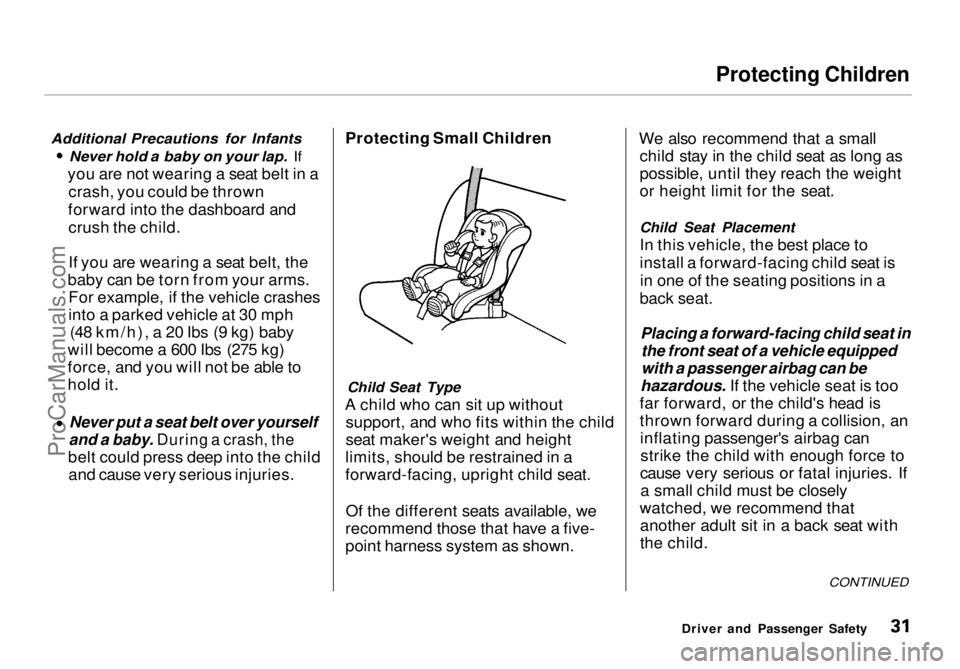
Protecting Children
Additional Precautions for Infants Never hold a baby on your lap. If
you are not wearing a seat belt in a crash, you could be thrown
forward into the dashboard and crush the child.
If you are wearing a seat belt, the
baby can be torn from your arms. For example, if the vehicle crashes
into a parked vehicle at 30 mph (48 km/h), a 20 Ibs (9 kg) baby
will become a 600 Ibs (275 kg)
force, and you will not be able to
hold it.
Never put a seat belt over yourself
and a baby. During a crash, the
belt could press deep into the child and cause very serious injuries. Protecting Small Children
Child Seat Type
A child who can sit up without support, and who fits within the child
seat maker's weight and height
limits, should be restrained in a
forward-facing, upright child seat.
Of the different seats available, we
recommend those that have a five-
point harness system as shown. We also recommend that a small
child stay in the child seat as long as
possible, until they reach the weight
or height limit for the seat.
Child Seat Placement In this vehicle, the best place to
install a forward-facing child seat is in one of the seating positions in a
back seat.
Placing a forward-facing child seat inthe front seat of a vehicle equipped
with a passenger airbag can be
hazardous. If the vehicle seat is too
far forward, or the child's head is
thrown forward during a collision, an inflating passenger's airbag canstrike the child with enough force to
cause very serious or fatal injuries. If a small child must be closely
watched, we recommend that another adult sit in a back seat with
the child.
Driver and Passenger Safety
CONTINUEDProCarManuals.comMain Menu Table of Contents s t
Page 34 of 272
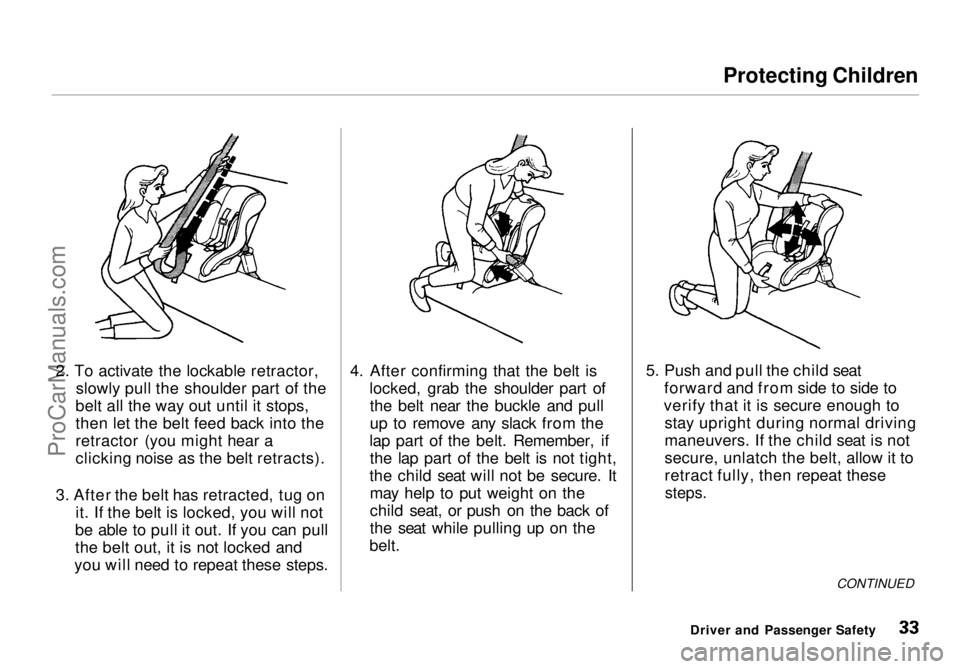
Protecting Children
2. To activate the lockable retractor, slowly pull the shoulder part of the
belt all the way out until it stops,
then let the belt feed back into the
retractor (you might hear a
clicking noise as the belt retracts).
3. After the belt has retracted, tug on it. If the belt is locked, you will not
be able to pull it out. If you can pull
the belt out, it is not locked and
you will need to repeat these steps. 4. After confirming that the belt is
locked, grab the shoulder part ofthe belt near the buckle and pull
up to remove any slack from the
lap part of the belt. Remember, if the lap part of the belt is not tight,
the child seat will not be secure. It may help to put weight on the
child seat, or push on the back of
the seat while pulling up on the
belt. 5. Push and pull the child seat
forward and from side to side to
verify that it is secure enough to stay upright during normal driving
maneuvers. If the child seat is not
secure, unlatch the belt, allow it to
retract fully, then repeat these
steps.
CONTINUED
Driver and Passenger SafetyProCarManuals.comMain Menu Table of Contents s t
Page 35 of 272
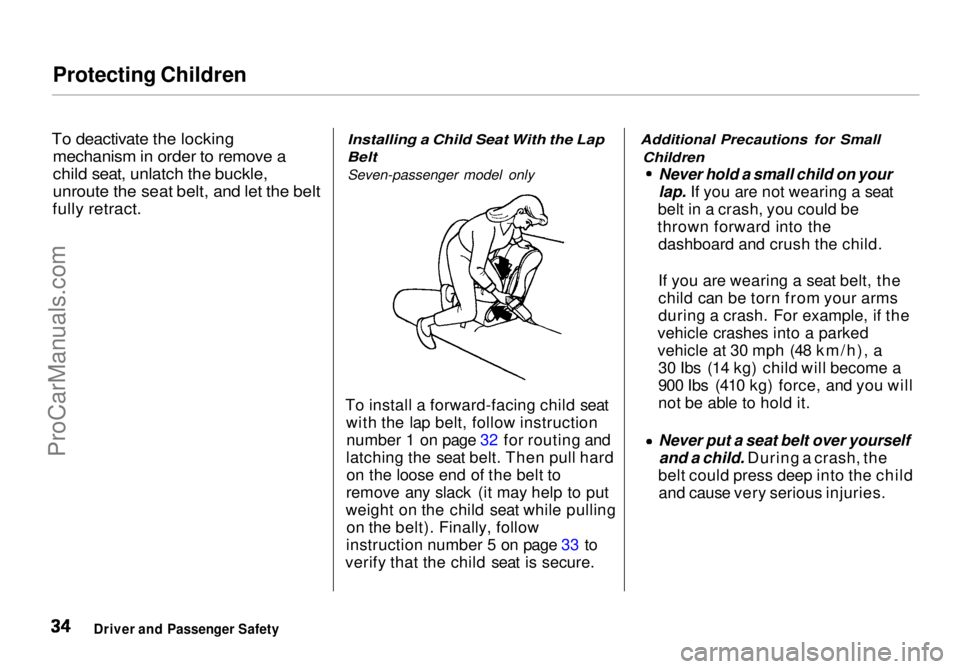
Protecting Children
To deactivate the locking
mechanism in order to remove a
child seat, unlatch the buckle,
unroute the seat belt, and let the belt
fully retract.
Installing a Child Seat With the Lap
Belt
Seven-passenger model only
To install a forward-facing child seat with the lap belt, follow instructionnumber 1 on page 32 for routing and
latching the seat belt. Then pull hard on the loose end of the belt to
remove any slack (it may help to put
weight on the child seat while pulling on the belt). Finally, follow
instruction number 5 on page 33 to
verify that the child seat is secure.
Additional Precautions for Small
Children
Never hold a small child on your
lap. If you are not wearing a seat
belt in a crash, you could be
thrown forward into the dashboard and crush the child.
If you are wearing a seat belt, the
child can be torn from your arms
during a crash. For example, if the
vehicle crashes into a parked
vehicle at 30 mph (48 km/h), a 30 Ibs (14 kg) child will become a
900 Ibs (410 kg) force, and you will
not be able to hold it.
Never put a seat belt over yourself
and a child. During a crash, the
belt could press deep into the child and cause very serious injuries.
Driver and Passenger SafetyProCarManuals.comMain Menu Table of Contents s t
Page 36 of 272
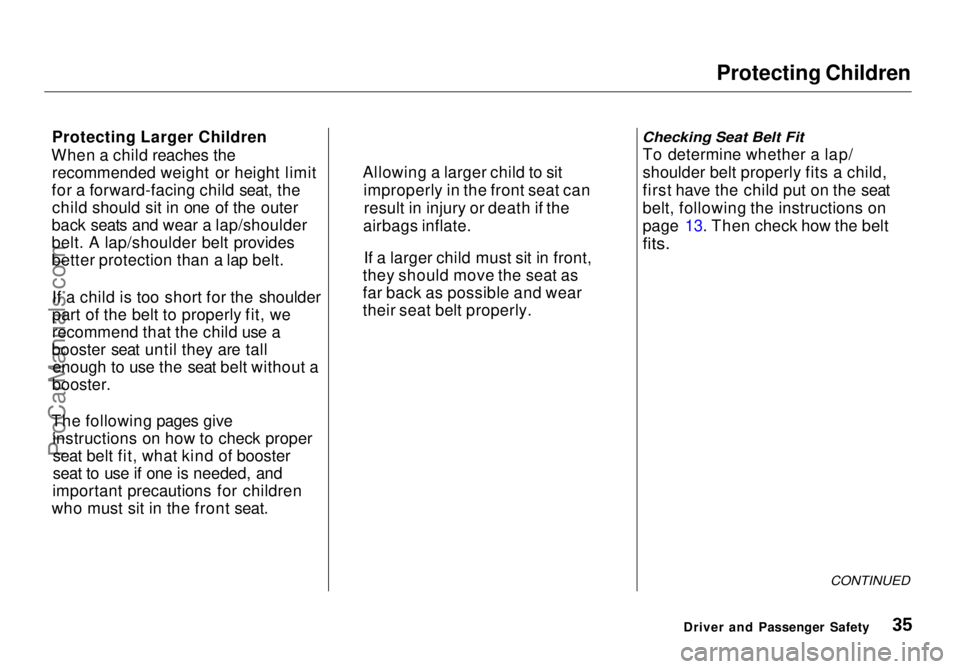
Protecting Children
Protecting Larger Children
When a child reaches the recommended weight or height limit
for a forward-facing child seat, the child should sit in one of the outer
back seats and wear a lap/shoulder
belt. A lap/shoulder belt provides
better protection than a lap belt.
If a child is too short for the shoulder
part of the belt to properly fit, we
recommend that the child use a
booster seat until they are tall enough to use the seat belt without a
booster.
The following pages give instructions on how to check properseat belt fit, what kind of booster
seat to use if one is needed, and
important precautions for children
who must sit in the front seat.
Checking Seat Belt Fit
To determine whether a lap/
shoulder belt properly fits a child,
first have the child put on the seat
belt, following the instructions on
page 13. Then check how the belt
fits.
CONTINUED
Driver and Passenger Safety
Allowing a larger child to sit
improperly in the front seat canresult in injury or death if the
airbags inflate.
If a larger child must sit in front,
they should move the seat as
far back as possible and wear
their seat belt properly.ProCarManuals.comMain Menu Table of Contents s t